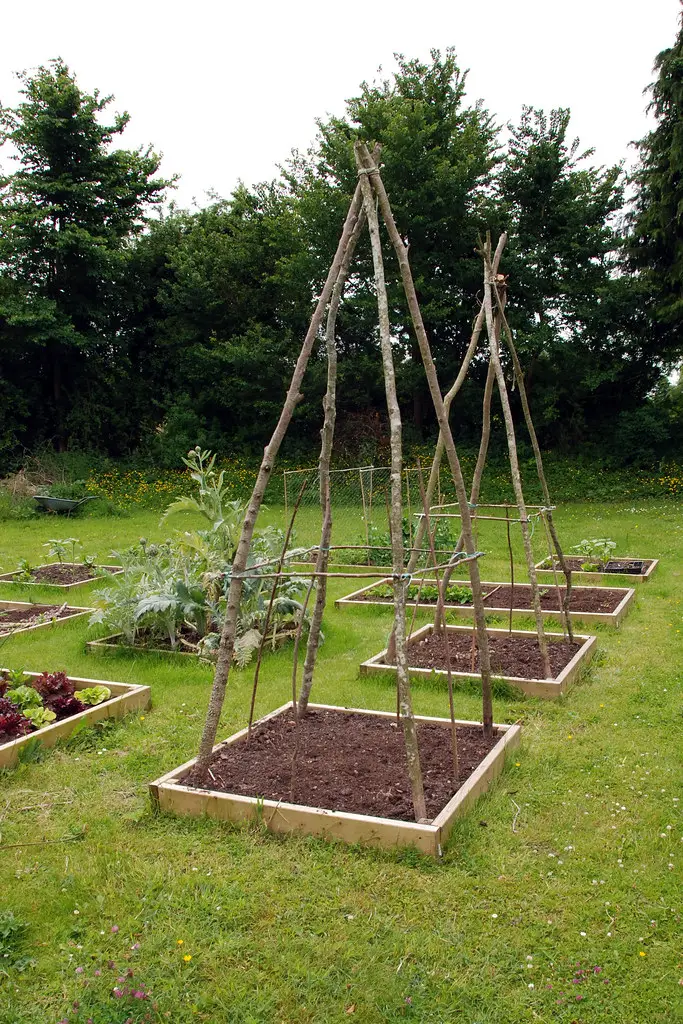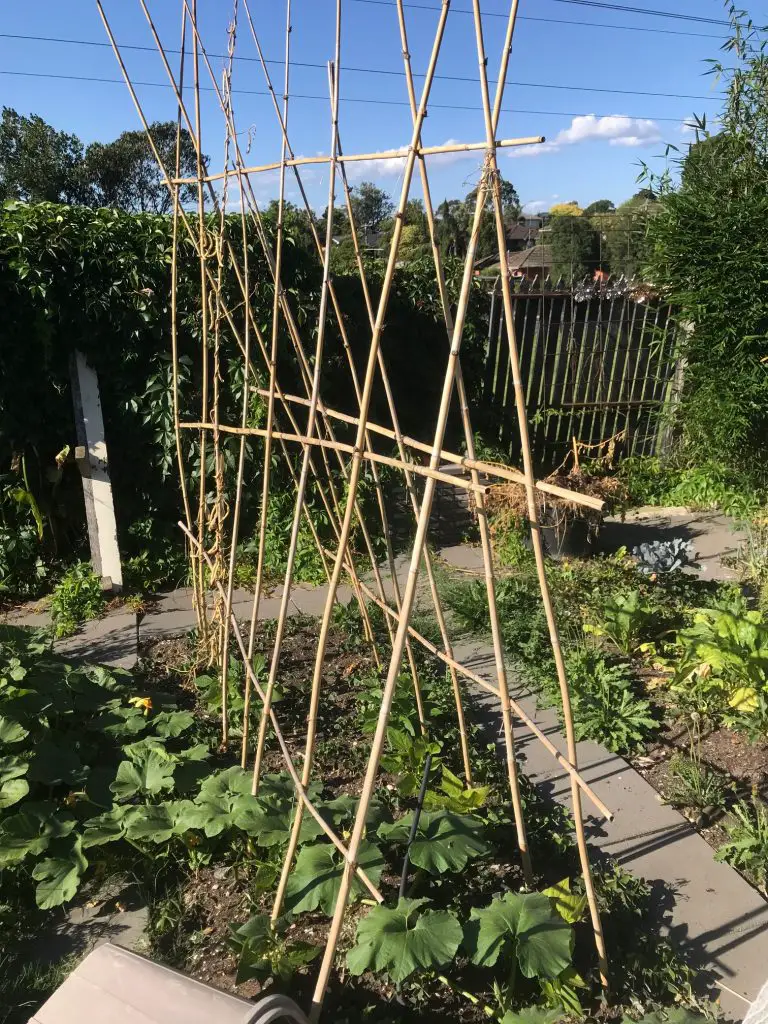How Do You Make A Support For Sweet Peas? Sweet peas are an extremely popular flower that is grown the world over because it produces massive flowers throughout the season. However, to grow the plant successfully it needs to be supported by a structure so how do you make one?
The method that is most commonly used by home gardeners to support sweet peas a wigwam. However, for those that are a little bit more serious about producing cut flowers for inside the house or growing the plants for a show the best method to use is column support. This method generally produces high-quality flowers over time and also helps to reduce the amount of required maintenance once the plants increase in size.
The reason why growing the flowers in a column produces higher quality flowers is because the structure of plant allows more sunlight to hit each flower. When growing plants in a column the grower only allows a single strand to be to be grown on a support rather than multiple stems.
Creating A Traditional Support Structure
If you are a traditionalist and want to grow sweet peas on a wigwam or traditional pea supports they are fairly easy to make. To start collect a number of long pieces of bamboo or hazel sticks or anything of that nature that is ideally around 6 to 8ft tall to ensure that the structure is large enough to accommodate the plant.
At home, I personally have bamboo plants that produce canes that are up to 10ft long that I harvest every year for the purposes of creating these types of supports. If you are a avid gardener and grow a lot of climbing plants like peas or beans planting a bamboo plant of your own is an excellent way to reduce your ongoing costs will provide you with canes for life. However, when purchasing bamboo make sure you get a clumping variety rather than a running variety as they can become weeds.
Making A Wigwam
Wigram probably the easiest and quickest support and can be made in a matter of a few minutes. To start creating the support structure the first thing to do is to ensure that you select a sunny area that is actually suitable to grow sweet peas. In terms of the area required I typically would allow between 5 and 8 ft square.
To ensure that the support is relatively stable it is best to start by inserting the bamboo or hazel canes into the ground to a depth of approximately 1ft. The canes themselves should be placed in a circle with each cane standing upright at a distance of approximately a foot apart however the actual size and distance will depend upon the height of the Canes you have.
If you have relatively short canes you may consider putting the canes closer together. Once the canes are in the ground then you will need some twine to tie all of the canes together at the top of the structure. When doing this you will need to ensure that the canes meet above the centre of the circle at which point you can tie them into the position.
For many people, once this is done they have their wigwam and it’s done, however, if you want something a little bit more elaborate you can also put in horizontal structures between each upright which will aid in the stability of the structure and also allow the plant to climb the structure more easily.
These horizontal supports can sometimes just be as simple as twine being run between the two upright support or they can be separate pieces of time that a tied to the upright supports either way the structure will benefit from this and it will also give you more flexibility in how you tie the sweet peas to the structure. See the image below for a completed wigwam.

Building A Traditional Pea Support Structure
The other type of really commonly used support for sweet peas is the traditional pea support which is created by placing the cames in two lines that are approximately 2 to 3 feet apart with the cane being inserted into the ground every foot or so. To ensure that they are stable the canes need to be driven into the ground to a depth of approximately a foot.
The canes within the line that are facing each other are then bent over until they meet and then tied together to form a series of triangle shapes which form the support of the pea structure.
To stabilize the triangle supports, which at this stage will be quite flimsy, a single cane is placed along the top of the triangle supports to join them together. To further strengthen the structure canes are placed along the sides of triangle to create greater strength and stability.
If you have flexible canes then it is also a good idea to weave them in and out of the supports to increase the strength of the structure. An image of a pea support is shown below.

Building A Column Structure For Sweet Peas
To grow sweet peas on string in a column structure you require the support structure to be stronger around the outer part of the frame as this is the primary area that supports all the sweet peas within the structure. As such it is advisable to use relatively thick timber around the outside of the frame which should be a height of around 5 to 8ft depending upon your own height.
The support needs to be convenient for you to be able to reach the top part of the structure and tie strings around the top of the support of the structure.
To erect the structure start by creating two upright posts on either end of where you’re going to plant the sweet peas. Attach a crosspiece between the posts that is at the top. The pieces of timber that this structure is made out of should be relatively thick so that it is capable of supporting the weight of all of the sweet peas that you’re going to grow.
The cross piece can be attached either using string or screws however the method that you use will greatly depend on the materials that you’re using to construct the support.
Once the upper crosspiece is attached it is advisable to create a lower crosspiece that is very close to the ground, only an inch or 2 is recommended as the unsupported sweet peas need to reach the bottom of this area.
To create the columns for each sweet pea to grow on attach string vertically between the two cross struts. This string should be relatively taught between the two pieces to ensure that it gives the sweet pea the support that it’s required. The strings should be attached approximately 2 to 3 inches apart to ensure that there is sufficient space for plants.
Once the columns are in place the sweet peas can be planted at the base of the structure with the aim of having one plant per upright that is on your structure. If you are planting from seed we highly recommend that you plant a few sweet pea seeds to ensure that you get at least one plants that can then climb up the structure.
If all the seeds germinate it is important to remove the weaker seedlings leaving the strongest one to grow up the structure.
When the sweet peas reach the base of the string they can be wound around the string. This process will need to be done repeatedly every week or so as the plant gets taller to ensure it is adequately supported. Any side shoots need to be removed as they appear leaving a single stem running up the string. To see a demonstration of this technique watch the short video below.
I hope that you found this article useful and you have great success with your sweet peas. If you have any questions or comments please leave them in the section below.
Relevant Articles
What’s The Difference Between Sweet Peas And Green Peas? (What You Need To Know)
How To Grow Sweet Peas Up Canes
What is difference between Dwarf Beans and Climbing Beans?
